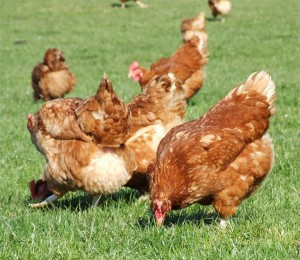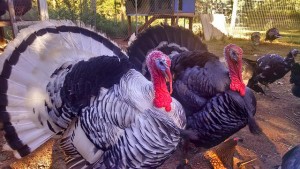Poultry Diseases
Blackhead
Also known as: Histomoniasis, Enterohepatitis, Infectious Enterohepatitis
This is an important condition of outdoor reared poultry, particularly turkeys. The causative agent is the protozoan parasite Histomonas meleagridis, which invades the caecal mucosa and spreads, via blood, to the liver. Lesions occur in the caecum and liver. Clinical signs include anorexia, depression and yellow droppings. Mortality rates may be very high, and reach a peak one week after the onset of the first clinical signs.
Transmission can occur via the eggs of the caecal nematode Heterakis gallinarum, and also the earthworm. These ensure the safe passage of the delicate parasite and ensure persistence of the infection in soil. The blackhead organism is very susceptible to environmental conditions, but when encased in Heterakis eggs or earthworms, it may remain viable for several years (Lund, 1969).
However, the role of direct transmission is becoming better understood, and it has been demonstrated that blackhead can spread rapidly in turkeys, but not chickens, by direct contact, probably involving the phenomenon of cloacal drinking (McDougald, 2005). In one experiment, uninfected turkey poults were placed in pens adjacent to directly inoculated poults (with no other potential carrier present). The infected birds quickly became sick and died. These results suggest that even though H. gallinarum is the only known reservoir for H. meleagridis, lateral transmission of histomoniasis can occur via normal contact between uninfected birds and infected birds and their droppings, without the presence of cecal worms. (McDougald and Hu, 2003). Please see the Poultry Site for further information. In the USA, it was observed that turkeys acquired blackhead when maintained on chicken yards that had been vacant for two years (Lund and Chute, 1974). To be virulent, bacteria must be present, notably Escherichia coli, Bacillus subtilis, and Clostridium spp., (Doll and Franker, 1963; McDougald, 2005).
The susceptibility to Blackhead varies greatly between different species of galliform birds. Turkeys and chukar partridges are prone to develop severe disease upon infection, with excessive morbidity and mortality up to 100%, while chickens are able to survive and persist as carrier animals (McDougald, 2005).
Histomonas meleagridis was held primarily responsible for an outbreak of 6% increased mortality and 11% decreased egg production between weeks 57 and 72 in a flock of free-range layer hens, concurrently infected with Brachyspira-like bacteria. This case was reported as an example of ancient diseases re-emerging in alternative housing systems (Esquenet et al., 2003). Blackhead diagnosed in a flock of 6-wk-old chickens was the first report of the presence of histomonads in the bursa of Fabricius in commercial chickens.
Control and Prevention of Blackhead

Free range poultry at pasture are particularly at risk as the parasite lifecycle can involve transmission via earthworms
Control should be focused on the role of carrier chickens and earthworms.
Range rotation may not be a practical option in situations where turkeys and chickens are kept on the same premises, since the Heterakis eggs survive in the soil for such a long period. Survival may be reduced in paddocks that are well drained and situated in a sunny location.
There are breed differences in susceptibility to Blackhead . Resistant breeds provide a source of contamination for other less tolerant breeds. The Rhode Island Red have been shown to be more resistant than other breeds (Lund, 1969).
Immunisation is not an option for prevention, as birds do not reliably become resistant to re-infection after suffering a primary exposure (McDougald, 2005).
Blackhead tends to become a problem if birds are already challenged by some other health or management stress.
Treating Blackhead
Historically Dimetridazole was used for prophylaxis or treatment in turkeys and game birds, but it has been withdrawn from use in food-producing poultry (Pattison et al, 2008). However, there have been good results shown using essential oils and herbal products with extracts from cinnamon, garlic, lemon, and rosemary as an effective preventive or curative treatment of H. meleagridis (Zenner et al., 2003; Hafez and Hauck, 2006). Consult your veterinarian for further advice.
Good Practice Based on Current Knowledge
- Ensure paddocks are regularly rotated, particularly if turkeys are also kept on the same premises.
- Turkeys should not be kept on the same paddocks as chickens. If this is not possible, turkeys should never follow chickens
- Paddocks and ranges should be well-drained and in a sunny location
See also Heterakis infestation.


 American English
American English


Comments are closed.